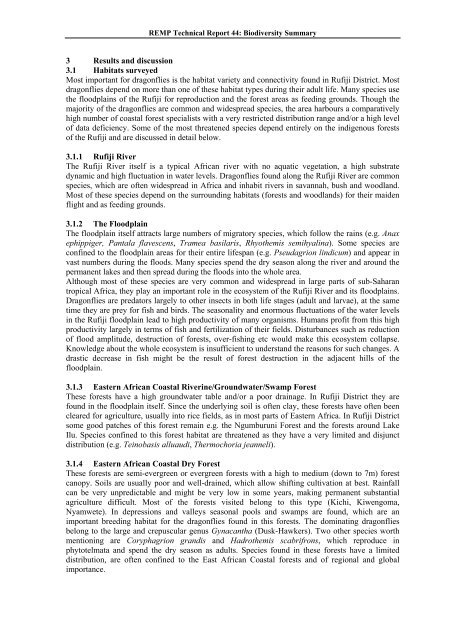Family / Scientific name - Coastal Forests of Kenya and Tanzania
Family / Scientific name - Coastal Forests of Kenya and Tanzania
Family / Scientific name - Coastal Forests of Kenya and Tanzania
You also want an ePaper? Increase the reach of your titles
YUMPU automatically turns print PDFs into web optimized ePapers that Google loves.
REMP Technical Report 44: Biodiversity Summary<br />
3 Results <strong>and</strong> discussion<br />
3.1 Habitats surveyed<br />
Most important for dragonflies is the habitat variety <strong>and</strong> connectivity found in Rufiji District. Most<br />
dragonflies depend on more than one <strong>of</strong> these habitat types during their adult life. Many species use<br />
the floodplains <strong>of</strong> the Rufiji for reproduction <strong>and</strong> the forest areas as feeding grounds. Though the<br />
majority <strong>of</strong> the dragonflies are common <strong>and</strong> widespread species, the area harbours a comparatively<br />
high number <strong>of</strong> coastal forest specialists with a very restricted distribution range <strong>and</strong>/or a high level<br />
<strong>of</strong> data deficiency. Some <strong>of</strong> the most threatened species depend entirely on the indigenous forests<br />
<strong>of</strong> the Rufiji <strong>and</strong> are discussed in detail below.<br />
3.1.1 Rufiji River<br />
The Rufiji River itself is a typical African river with no aquatic vegetation, a high substrate<br />
dynamic <strong>and</strong> high fluctuation in water levels. Dragonflies found along the Rufiji River are common<br />
species, which are <strong>of</strong>ten widespread in Africa <strong>and</strong> inhabit rivers in savannah, bush <strong>and</strong> woodl<strong>and</strong>.<br />
Most <strong>of</strong> these species depend on the surrounding habitats (forests <strong>and</strong> woodl<strong>and</strong>s) for their maiden<br />
flight <strong>and</strong> as feeding grounds.<br />
3.1.2 The Floodplain<br />
The floodplain itself attracts large numbers <strong>of</strong> migratory species, which follow the rains (e.g. Anax<br />
ephippiger, Pantala flavescens, Tramea basilaris, Rhyothemis semihyalina). Some species are<br />
confined to the floodplain areas for their entire lifespan (e.g. Pseudagrion lindicum) <strong>and</strong> appear in<br />
vast numbers during the floods. Many species spend the dry season along the river <strong>and</strong> around the<br />
permanent lakes <strong>and</strong> then spread during the floods into the whole area.<br />
Although most <strong>of</strong> these species are very common <strong>and</strong> widespread in large parts <strong>of</strong> sub-Saharan<br />
tropical Africa, they play an important role in the ecosystem <strong>of</strong> the Rufiji River <strong>and</strong> its floodplains.<br />
Dragonflies are predators largely to other insects in both life stages (adult <strong>and</strong> larvae), at the same<br />
time they are prey for fish <strong>and</strong> birds. The seasonality <strong>and</strong> enormous fluctuations <strong>of</strong> the water levels<br />
in the Rufiji floodplain lead to high productivity <strong>of</strong> many organisms. Humans pr<strong>of</strong>it from this high<br />
productivity largely in terms <strong>of</strong> fish <strong>and</strong> fertilization <strong>of</strong> their fields. Disturbances such as reduction<br />
<strong>of</strong> flood amplitude, destruction <strong>of</strong> forests, over-fishing etc would make this ecosystem collapse.<br />
Knowledge about the whole ecosystem is insufficient to underst<strong>and</strong> the reasons for such changes. A<br />
drastic decrease in fish might be the result <strong>of</strong> forest destruction in the adjacent hills <strong>of</strong> the<br />
floodplain.<br />
3.1.3 Eastern African <strong>Coastal</strong> Riverine/Groundwater/Swamp Forest<br />
These forests have a high groundwater table <strong>and</strong>/or a poor drainage. In Rufiji District they are<br />
found in the floodplain itself. Since the underlying soil is <strong>of</strong>ten clay, these forests have <strong>of</strong>ten been<br />
cleared for agriculture, usually into rice fields, as in most parts <strong>of</strong> Eastern Africa. In Rufiji District<br />
some good patches <strong>of</strong> this forest remain e.g. the Ngumburuni Forest <strong>and</strong> the forests around Lake<br />
Ilu. Species confined to this forest habitat are threatened as they have a very limited <strong>and</strong> disjunct<br />
distribution (e.g. Teinobasis alluaudi, Thermochoria jeanneli).<br />
3.1.4 Eastern African <strong>Coastal</strong> Dry Forest<br />
These forests are semi-evergreen or evergreen forests with a high to medium (down to 7m) forest<br />
canopy. Soils are usually poor <strong>and</strong> well-drained, which allow shifting cultivation at best. Rainfall<br />
can be very unpredictable <strong>and</strong> might be very low in some years, making permanent substantial<br />
agriculture difficult. Most <strong>of</strong> the forests visited belong to this type (Kichi, Kiwengoma,<br />
Nyamwete). In depressions <strong>and</strong> valleys seasonal pools <strong>and</strong> swamps are found, which are an<br />
important breeding habitat for the dragonflies found in this forests. The dominating dragonflies<br />
belong to the large <strong>and</strong> crepuscular genus Gynacantha (Dusk-Hawkers). Two other species worth<br />
mentioning are Coryphagrion gr<strong>and</strong>is <strong>and</strong> Hadrothemis scabrifrons, which reproduce in<br />
phytotelmata <strong>and</strong> spend the dry season as adults. Species found in these forests have a limited<br />
distribution, are <strong>of</strong>ten confined to the East African <strong>Coastal</strong> forests <strong>and</strong> <strong>of</strong> regional <strong>and</strong> global<br />
importance.

















